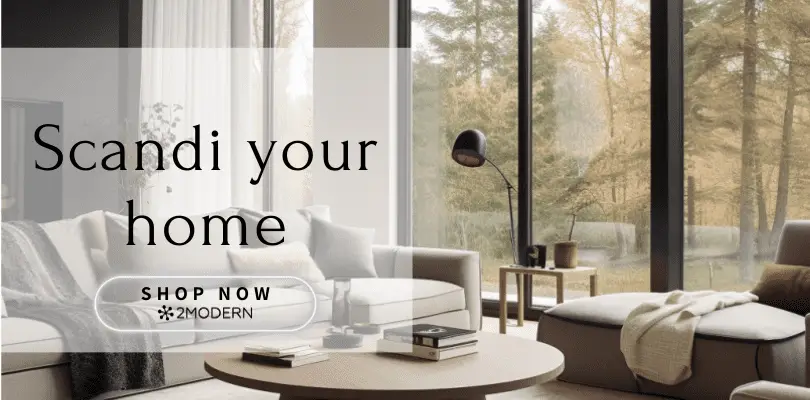
Have you ever walked into a room that instantly made you feel at ease, surrounded by simplicity and understated elegance? Chances are, you’ve experienced the charm of Scandinavian interior design. With its minimalist and functional approach, this style has won over the hearts of homeowners and designers alike. So, let’s dive into the world of Scandinavian interior design, explore its origins, key elements, and how to incorporate it into your living space. Who knows, you might even find some inspiration for your own cozy Nordic haven!

Table of Contents
A Brief History: The Roots of Scandinavian Design
Before we delve into the core aspects of Scandinavian design, it’s essential to understand where it all began. The style originated in the early 20th century in the Nordic countries of Sweden, Denmark, Norway, Finland, and Iceland. The main driving force behind the Scandinavian design was the desire to create simple, functional, and affordable living spaces, responding to the region’s harsh climate and scarce resources.
The modernist movement of the 1950s significantly influenced Scandinavian design, propelling it onto the international stage. Its core tenets of functionality, simplicity, and minimalism have since been embraced by people worldwide (read more about Scandinavian design history here).
Key Elements of Scandinavian Design: The Beauty of Simplicity
Now that we have a basic understanding of the roots of Scandinavian design let’s explore the essential elements that make it so unique and enduring.
Minimalism and Functionality: At the heart of Scandinavian Interior design lies the emphasis on minimalism and functionality. This design philosophy is all about stripping away the unnecessary and focusing on clean lines, practicality, and ease of use. It’s about making the most of the available space and ensuring that everything has a purpose.

Neutral Color Palette: One of the most recognizable features of Scandinavian Interior design is its neutral color palette. Soft hues of white, gray, and beige dominate the scene, creating a sense of harmony and serenity. However, you can always add pops of color through accessories or artwork to bring some personality and warmth to the space.
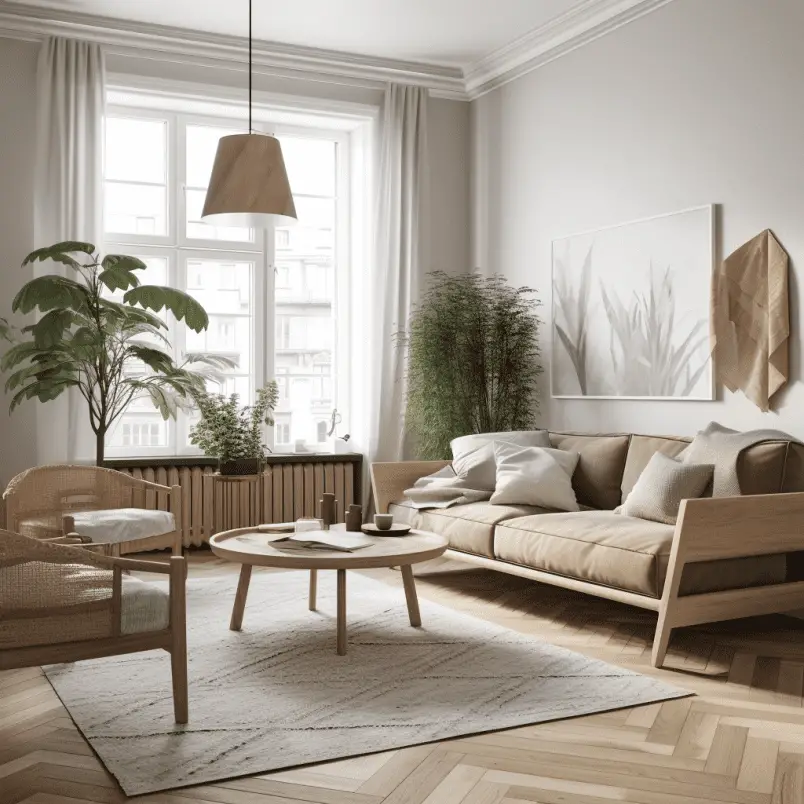
Natural Materials: Scandinavian interior design is deeply rooted in nature, so you’ll often find materials such as wood, stone, and leather incorporated into the design. These natural elements not only add warmth and texture to the space but also serve as a reminder of the Nordic landscape.

Light and Airiness: Given the long, dark winters in the Nordic countries, maximizing natural light is a crucial aspect of Scandinavian interior design. Large windows, light-colored walls, and minimal window treatments work together to create a bright and airy atmosphere.

Coziness and Comfort: Despite its minimalist approach, Scandinavian design never compromises on comfort. Plush rugs, soft cushions, and cozy blankets are essential elements that create a warm and inviting atmosphere.

Incorporating Scandinavian Design into Your Home: Tips and Tricks
Ready to bring some Scandinavian charm into your living space? Here are a few tips to help you get started:
- Declutter: One of the first steps in embracing Scandinavian design is to declutter your space. Keep only the essentials and focus on creating a clean, clutter-free environment.
- Choose Quality over Quantity: When selecting furniture and accessories, prioritize quality over quantity. Invest in well-made, timeless pieces that will last for years to come.
- Incorporate Nature: Bring the outdoors in by adding plants and natural elements to your space. This could be as simple as displaying a vase of fresh flowers or incorporating wooden furniture.
- Play with Textures: To add depth and interest to your space, experiment with different textures. Combine soft rugs, linen cushions, and chunky knit throws for a cozy and inviting atmosphere.
- Personalize Your Space: While Scandinavian design is characterized by its simplicity, don’t be afraid to inject your personality into the space. Add pops of color, artwork, or unique accessories that reflect your style and make the space truly yours.
Scandinavian Interior Design in Different Rooms: Creating Cohesive Spaces
Scandinavian interior design can be effortlessly adapted to various rooms in your home, creating a cohesive and inviting atmosphere throughout. Let’s explore how to apply this minimalist and cozy design style in different spaces, including the living room, bedroom, kitchen, and bathroom.
Living Room: A Welcoming and Comfortable Retreat
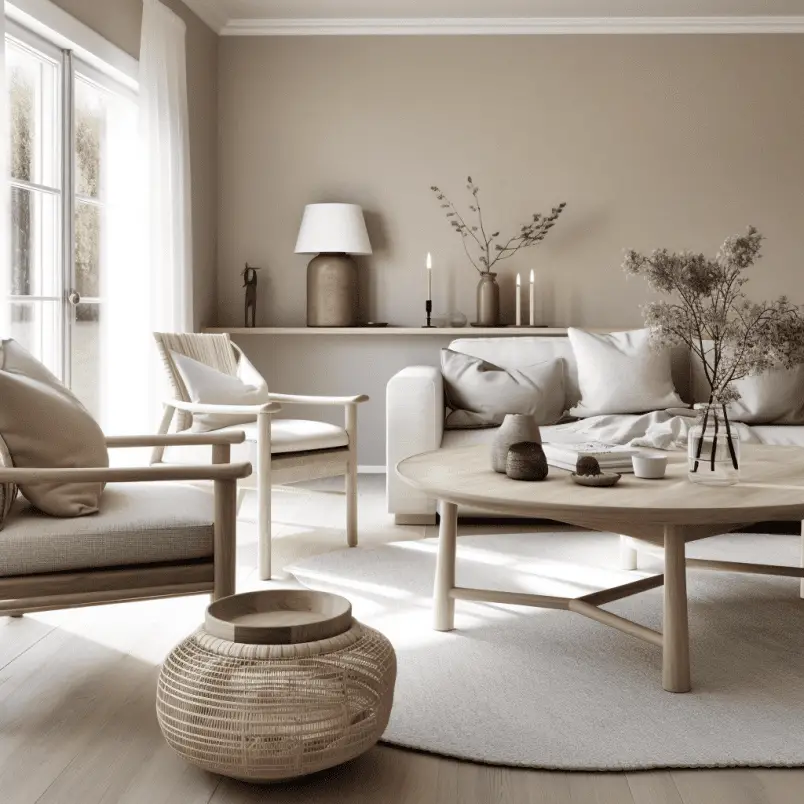
The living room is the heart of your home, where you entertain guests, unwind after a long day, or spend quality time with your family. To create a Scandinavian-inspired living space, focus on:
- Minimalist furniture: Opt for simple, clean-lined furniture pieces, such as a comfortable sofa, a wooden coffee table, and functional storage solutions like open shelves or a sleek TV console.
- Neutral color palette: Stick to a neutral color scheme with shades of white, gray, and beige. Add pops of color through artwork or accessories for a touch of personality.
- Layered textiles: Incorporate soft textiles, such as throw blankets, cushions, and a plush rug, to create a warm and inviting atmosphere.
- Natural light: Maximize natural light by using sheer curtains or leaving windows uncovered. Add floor lamps and pendant lights for a cozy ambiance in the evenings.
Bedroom: A Serene and Restful Sanctuary
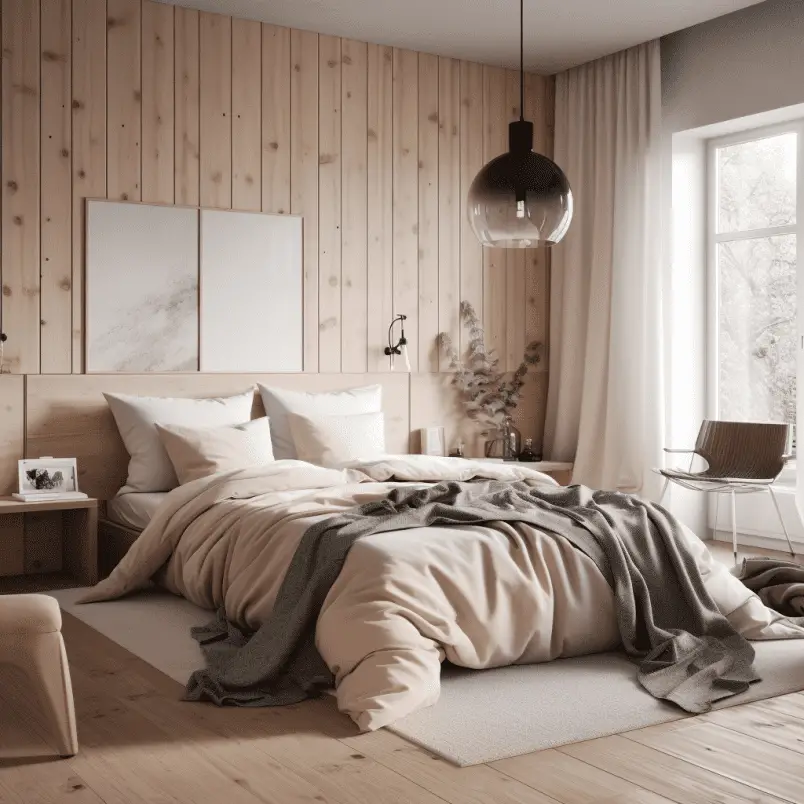
The bedroom is your personal sanctuary, where you can recharge and relax. To create a Scandinavian-inspired bedroom, consider the following:
- Simple, functional bed: Choose a bed frame with clean lines and a minimalist design, preferably in a light wood finish. Dress the bed with crisp white linens and a cozy duvet.
- Soft lighting: Opt for warm, ambient lighting with table lamps, wall sconces, or a pendant light to create a soothing atmosphere.
- Minimalist storage: Select functional and simple storage solutions, such as a sleek dresser, open shelves, or a wardrobe with clean lines.
- Natural elements: Incorporate plants, wooden furniture, or woven baskets to bring a touch of nature into the space.
Kitchen: A Sleek and Efficient Workspace
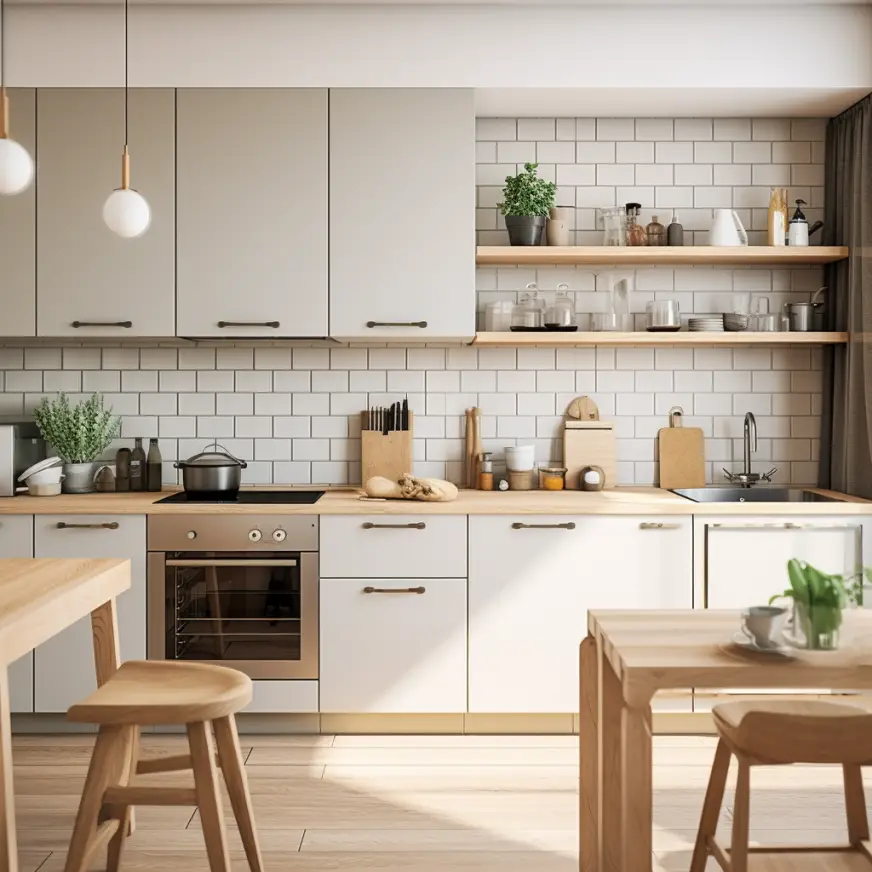
Scandinavian interior design principles can also be applied to your kitchen, creating a stylish and efficient workspace. Here’s how:
- Streamlined cabinetry: Choose cabinetry with flat-panel doors and simple hardware for a clean, minimalist look. White or light wood finishes work best in Scandinavian kitchens.
- Open shelving: Incorporate open shelves to display your favorite dishes, glassware, or cookbooks. This adds personality and warmth to the space while keeping it functional.
- Practical countertops: Opt for durable, low-maintenance countertop materials such as quartz or stainless steel.
- Neutral backsplash: Keep the backsplash simple and neutral, using materials like subway tiles or a light-colored stone.
Bathroom: A Calming and Functional Oasis

Lastly, Scandinavian interior design can transform your bathroom into a calming and functional oasis. To achieve this, focus on:
- Minimalist fixtures: Select sleek and simple fixtures, such as a wall-mounted sink, a frameless mirror, and streamlined faucets.
- Neutral color scheme: Stick to a neutral color palette with white, gray, or beige tiles and paint. Add pops of color with towels or accessories for a personal touch.
- Natural materials: Incorporate wooden elements, such as a floating vanity or a wooden bath mat, to bring warmth to the space.
- Adequate lighting: Ensure there is plenty of light, both natural and artificial, to create a bright and inviting atmosphere.
Pros of Scandinavian Interior Design
- Simplicity and Functionality: One of the main benefits of Scandinavian design is its focus on simplicity and functionality. This design philosophy prioritizes practicality, making it easy to maintain and keep your space clutter-free.
- Timeless Appeal: The clean lines and minimalist aesthetic of Scandinavian design make it a timeless choice that is less likely to go out of style compared to more trend-driven options.
- Versatility: The neutral color palette and minimalist approach of Scandinavian design allow it to blend seamlessly with various other styles. This versatility makes it easy to mix and match elements or update your space over time.
- Emphasis on Natural Elements: Scandinavian design celebrates nature, incorporating natural materials like wood, stone, and plants into the space. This connection to nature can create a soothing and calming atmosphere in your home.
- Bright and Airy Spaces: With its emphasis on maximizing natural light, Scandinavian design can make your home feel bright and spacious, even in smaller or darker rooms.
More scandi room inspiration




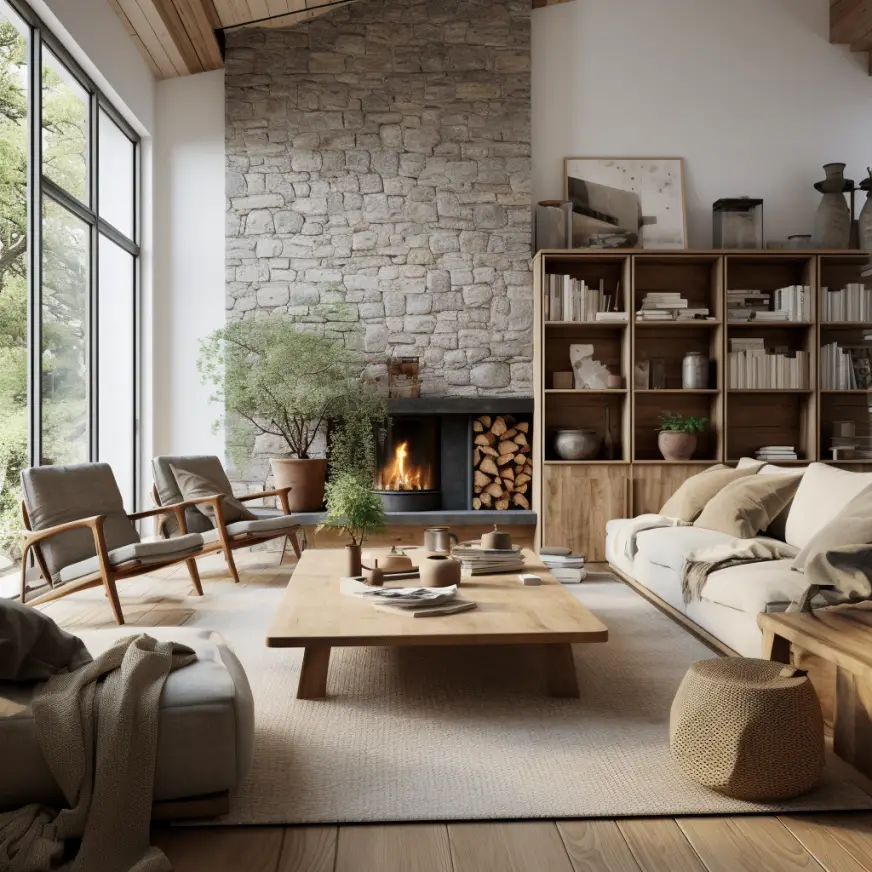

Cons of Scandinavian Interior Design
- Perceived as Cold or Sterile: The minimalist approach and neutral color palette can sometimes make Scandinavian spaces feel cold or sterile. However, this can be mitigated by adding warmth through textiles, colors, and personal touches.
- Lack of Ornamentation: If you’re someone who loves intricate details and elaborate decor, Scandinavian design might not be the right choice for you, as it favors simplicity and minimalism over ornate decoration.
- Neutral Colors May Feel Monotonous: The predominance of white, gray, and beige in Scandinavian design might feel monotonous or bland for some people. However, you can always add pops of color and personality through accessories, artwork, or textiles.
- Not Ideal for Large Families or Clutter-Prone Individuals: The minimalist approach of Scandinavian design might not be practical for large families or those who struggle to keep their spaces clutter-free, as it requires regular maintenance and organization.
- Potential Higher Costs for Quality Pieces: Investing in high-quality, well-made furniture and accessories is essential in Scandinavian design. This can sometimes result in higher costs, especially if you’re starting from scratch or looking to replace multiple items in your home.
Conclusion
Scandinavian interior design has stood the test of time, thanks to its versatile and timeless nature. The emphasis on functionality, minimalism, and comfort has made it a popular choice for homeowners and designers worldwide. By incorporating the key elements of Scandinavian design into your living space, you can create a cozy, inviting, and stylish environment that is sure to impress.
In summary, Scandinavian interior design offers many advantages, such as simplicity, functionality, and timeless appeal. However, it also has some drawbacks, such as the potential for a cold or sterile atmosphere and a lack of ornamentation. By weighing the pros and cons, you can decide if this design style aligns with your personal preferences and lifestyle.
FAQ
What is the main focus of Scandinavian interior design?
The primary focus of Scandinavian interior design is on creating functional, simple, and minimalist living spaces that prioritize comfort and natural elements.
Can I incorporate other design styles into a Scandinavian-themed space?
Absolutely! Scandinavian design is quite versatile, and you can easily mix and match elements from other design styles, such as modern, industrial, or bohemian, to create a unique and personalized space.
What type of furniture works best in a Scandinavian-designed room?
Look for furniture pieces with clean lines, minimal ornamentation, and a focus on functionality. Opt for natural materials like wood, and prioritize quality over quantity.
How can I add warmth to a Scandinavian-style room?
To add warmth to a Scandinavian-style room, incorporate natural materials like wood and leather, and use soft textiles such as rugs, cushions, and blankets. Additionally, consider adding plants and other natural elements to the space.
What colors are typically used in Scandinavian design?
Scandinavian design is known for its neutral color palette, featuring shades of white, gray, and beige. However, you can always add pops of color through accessories, artwork, or textiles to bring warmth and personality to the space
